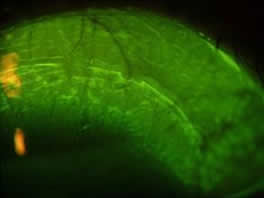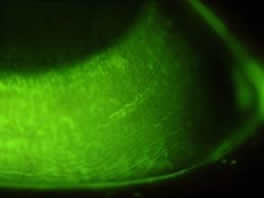A conjunctival response to silicone hydrogel lens wear
Tom Løfstrøm & Allan Kruse
Contact Lens Spectrum, September 2005
Contact lens induced conjunctival staining is commonly seen in soft contact lens wear. Indentation of the conjunctival tissue, seen as a thin band of fluorescein pooling, can also occur by itself, or in conjunction with conjunctival staining. As conjunctival staining and indentation are not usually associated with other signs or symptoms and occur frequently with both conventional hydrogel and silicone hydrogel lens wear, little attention has been given to the impact of the lens edge on the bulbar conjunctiva.
The Løfstrøm and Kruse paper details the first report of conjunctival epithelial flaps (CEFs) in a small group of successful silicone hydrogel continuous wearers. Diagrams and descriptions depict uneven margined tissue in the area adjacent to the lens edge, which could be manipulated by the lower lid. The conjunctival flaps varied in length and width between subjects and were located superior and/or inferior quadrants only (for examples see Figures 1 and 2). They occurred both in the presence of conjunctival staining and indentation, and alone, and typically originated from a slightly raised edge, that the authors believe is hyperplasic conjunctival epithelium. There was no evidence of fluorescein penetration in the region of the flap but pooling of fluorescein was evident.

|

|
Figure 1: Marked appearance of a conjunctival response in the superior region |
Figure 2: Subtle appearance of conjunctival response in the inferior region |
Conjunctival flaps are best visualized after instillation of fluorescein, and with a cobalt blue light, yellow barrier filter at high magnification, which is possibly why this subtle finding has not been observed prior to the authors’ discovery |
This study reports a prevalence of 34% (11/32 eyes) in silicone hydrogel continuous wear and is similar to the incidence rate found in another small scale study of silicone hydrogel continuous wear (27%) [1]. A larger study reported a much lower incidence rate in silicone hydrogel daily wear (3%) [2]. It is important to recognize that the Løfstrøm and Kruse study is a pilot study, involving a small number of wearers and only two lens types, lotrafilcon A and balafilcon A, and therefore provides an imprecise estimate of prevalence. Results of larger scale studies should provide a more reliable prevalence rate in continuous wear. (Note: prevalence refers to the total number of people with a condition at a particular time while incidence refers to the number of people that develop the condition over a particular time, usually one year).
An interesting finding of this study was the difference in the prevalence of conjunctival flaps between silicone hydrogel lens types and the authors postulate that a non-rounded edge design may be a significant factor in the development of conjunctival flaps. While modulus is likely to be a factor, the use of only two lens types of similar, albeit high, modulus does not give an indication of the effect of modulus. Differences between lens types in daily wear indicate higher modulus may increase the incidence rate of conjunctival flaps [2], at least in daily wear. The results of this study suggest a higher prevalence for the steeper base curve lens (8.4 mm). However, as the authors indicate, the small sample size means no conclusions can be drawn from this finding. In addition, patient factors such as eye shape may have influenced this result. It is also possible that lens binding during overnight wear, with subsequent movement upon awakening, might be a predisposing factor explaining why the rate is seemingly lower in daily wear.
The authors propose several hypotheses for the pathogenesis of conjunctival epithelial flaps:
- Delamination or splitting of the superficial conjunctiva
- Increased cell production or redistribution of epithelial cells
- Shredding of overgrowth of conjunctival cells facilitated by conjunctival chemosis and overnight lens wear
A recent study using impression cytology [3] (cellulose acetate filters are used to pick up a layer of cells from the conjunctival surface) recovered only healthy, vital epithelial cells and goblet cells from conjunctival flaps (i.e. no inflammatory cells, basement membrane or stromal cells). This suggests a mechanical etiology whereby the superficial conjunctiva is separated from the deeper tissue, which corresponds with the first hypothesis proposed in this paper.
While, as the authors state, lens factors, such as fitting, edge shape and parameters should be considerations in lens manufacture of silicone hydrogel materials, the relative contribution of these factors along with the modulus, in the pathogenesis of conjunctival epithelial flaps is not known. There may also be patient factors involved, such as eye shape, lid tension, age and tear film characteristics.
Anecdotally the Løfstrøm and Kruse paper reports no effect on lens wear satisfaction or subjective comfort and indeed, this is the clinical impression. To date there have been no reports of any complications associated with this response and no sign of associated inflammation or discomfort, even with follow-up greater than one year. In DW, no symptoms of discomfort or other adverse events were reported by subjects with conjunctival flaps [2], however, these flaps were smaller than those seen in continuous wear.
As clinicians it’s important that we are aware of this condition, but not be alarmed if we see it. From information to date, we would classify conjunctival epithelial flaps as an interesting finding, not an adverse event, but further studies are required to confirm the etiology and determine the clinical relevance, particularly in continuous wear. As it stands, the benefits of a silicone hydrogel lens compared to a conventional hydrogel lens for continuous wear far outweigh the existence of this intriguing clinical finding.
References
- Lakkis C et al. Clinical evaluation of a new non-surface treated silicone hydrogel lens during continuous wear; 2006 ARVO E-abstract.
- Lin M et al. Conjunctival epithelial flaps with silicone hydrogel lenses worn for daily wear; Optom Vis Sci 2005; 82: E-abstract 050078
- Thota S et al. Conjunctival flaps in silicone hydrogel lens wearers; 2006 ARVO E-abstract
|